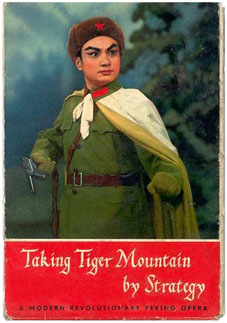 Taking Tiger Mountain (By Strategy) is familiar to those of us in the decadent west as the title of Brian Eno’s second solo album, released in 1974. Eno borrowed the title from a set of Chinese postcards depicting a performance of a Maoist opera, and you can now see a copy of those very postcards here.
Taking Tiger Mountain (By Strategy) is familiar to those of us in the decadent west as the title of Brian Eno’s second solo album, released in 1974. Eno borrowed the title from a set of Chinese postcards depicting a performance of a Maoist opera, and you can now see a copy of those very postcards here.
“The modern revolutionary Peking opera Taking Tiger Mountain by Strategy, carefully revised, perfected and polished to the last detail with our great leader Chairman Mao’s loving care, now glitters with surpassing splendour.
“Taking Tiger Mountain by Strategy is one of the outstanding model theatrical works. It describes an episode in the great Chinese People’s War of Liberation, a battle in which a pursuit detachment of the Chinese People’s Liberation Army wiped out a Kuomintang die-hard gang in northeast China. The opera creates the brilliant images of Yan Tzu-jung and other proletarian heroes by the method of combining revolutionary realism with revolutionary romanticism, and eulogizes Chairman Mao’s great thought on people’s war. The successful creation of the modern revolutionary Peking opera Taking Tiger Mountain by Strategy is a splendid victory for Chairman Mao’s revolutionary line on literature and art.”
Eno produced his own set of strategic cards with artist Peter Schmidt (who painted the cover of Tiger Mountain) a year later, Oblique Strategies, “Over one hundred worthwhile dilemmas.” Originally an expensive limited edition, these are now available in a variety of freeware applications or online versions. Best one if you’re among the 17% of Mac-users visiting this site is probably the Dashboard widget, the latest version of which includes the texts of all three editions. The instant access nature of OS X’s Dashboard is especially suited to small information systems such as this.
Previously on { feuilleton }
• Exodus art and Plague Songs
• Generative culture
• My Life in the Bush of Ghosts
